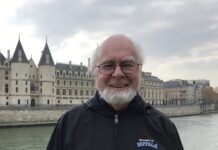During the early stages of the pandemic, there was significant debate about which methods would prove most effective for flattening the COVID-19 curve. One suggested way was herd immunity, a method in which the virus is allowed to spread with few restrictions so populations become naturally immunized to the virus.
Physics and Astronomy Professor at UW Professor Niayesh Afshordi has applied tools from observational cosmology to infectious disease modelling, specifically COVID-19, to understand the outcomes of herd immunity.
“If there are enough people in a community who are immune to a contagion […] if it’s an infectious disease, but it cannot actually find a person who is susceptible, then it’s not going to spread […] For that, you usually need a significant fraction of the population to become immune – either through vaccination or natural infection,” Afshordi said.
If individuals enter communities where a fraction of its people have already developed immunity through vaccines or prior infections, some exposures to the virus will not lead to new infections.
“If a large enough fraction of the community has immunity […], then it is said that the community has reached ‘herd immunity,’” Afshordi said.
Afshordi compared the beginning of the COVID-19 pandemic to rolling a bowling ball downhill – if a bowling ball is left to roll without intervention, predicting where the ball will end up and at what speed is difficult, and one can easily overshoot the target.
“If you just let the virus run wild, you’re going to, in fact, overshoot herd immunity – you’re going to get more people killed, more people infected than what’s required for herd immunity,” Afshordi said.
Here, Afshordi stressed the importance of using other mitigation methods, such as masks, social distancing procedures, and stay-at-home orders, to help support herd immunity and prevent future outbreaks. He adds that herd immunity is not a stand-alone strategy to combat COVID-19. Instead, the eventual probability/likelihood of a population developing herd immunity acts as additional information that can help experts design a strategy to control the pandemic/virus within communities. Each strategy will vary depending on the community.
“In a rural community without many social contacts, it may be feasible to reduce [infection rates] using non-pharmaceutical interventions, for a sustained period of time, until a vaccine becomes available and widely administered,” Afshordi said.
For urban areas, the reality is quite different — stricter measures that last more prolonged periods are needed to achieve the desired effects.
“In this case, the community may decide on a combination of restrictions and protective measures to keep the new infections at a low level, until herd immunity is reached. This is a risky strategy, as it could lead to many deaths, and other long-term conditions, due to COVID-19 infections, unless the most vulnerable citizens are well protected from those infected. That is why it is still necessary to use some level of non-pharmaceutical measures to minimize the daily new infections and its possible spread to those vulnerable,” Afshordi said.
The professor said vaccination is the best way to achieve herd immunity. He approximates that if 60 to 70 per cent of the population vaccinates, others might not have enough contacts to spread the infection further.





























